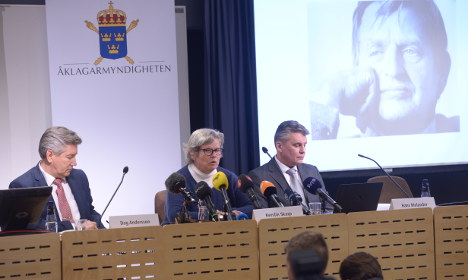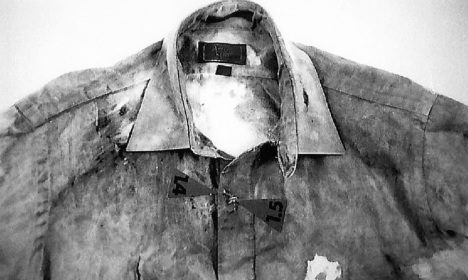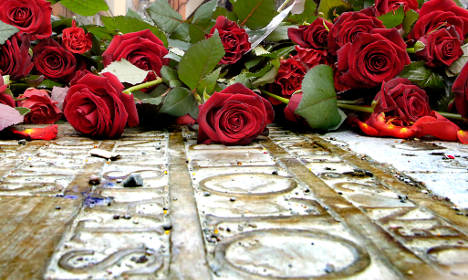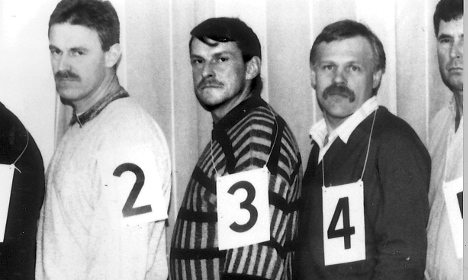Four odd things Sweden has done to solve ex-PM's murder

As the 30-year anniversary of the death of Swedish Prime Minister Olof Palme approaches, The Local looks at some of the things Sweden has done that still haven't solved the murder mystery.
Social Democrat Prime Minister Olof Palme was shot to death by an unknown assassin as he made his way home from the cinema with his wife on the evening of the 28th February 1986.
His murder is often seen as a watershed in Swedish society, which is still haunted by the fact that his killer was never identified. In the 30 years following his death, Sweden has tried in many ways to solve the murder. Here are some of the things that have failed to produce a result so far.
1. Launched the world's biggest murder probe
The Palme inquiry is officially bigger than both the JFK murder probe and the Lockerbie attack. A total of 10,225 people have been interrogated at least one time each, and in the data base used by the police team are 87,318 documents about people connected to the investigation.
According to police, it would take nine years for a person with legal training to read through all the documents and material connected to the investigation, which are all stored in special Palme archive and measure a whopping 250 metres of shelf space.

All these folders are part of the investigation. Photo: Fredrik Sandberg/TT
2. Kept officers working full-time on the investigation
Five police officers are part of the so-called 'Palme Group' ('Palmegruppen'), who, three decades later, spend most, but no longer all, of their working time investigating the murder. Despite being the butt of many jokes, the team claim they still manage to keep themselves busy interviewing new potential witnesses and testing shooting numerous guns to see if they can trace the murder weapon.
The 30-year investigation is estimated to have cost at least 350 million kronor ($41 million), although even higher figures have been mentioned. If they find a killer, there will be even more to pay: a 50 million kronor reward has been issued for whoever offers a lead strong enough to catch the shooter.

The Palme Group holding a press conference on Thursday. Photo: Fredrik Sandberg/TT
3. Abolished actual legislation to solve the crime
Sweden scrapped its 25-year statute of limitations for murder in 2010, suspiciously conveniently just a year before the 25th anniversary of the unsolved murder. This means that officers can continue to investigate the incident indefinitely.
The current head of the Palme Group, Hans Melander, has said: "A good day on the job is when you manage to reach the end of the line of something. If we get a tip that points at a certain person as a suspect and we can dismiss this person, that's a victory in itself. But that's obviously not the same as finding the right perpetrator."

The shirt Palme wore the night he was shot. Photo: Police
4. Opened a Palme telephone hotline
Yes, there is an actual Palme hotline. Every year on the anniversary of the murder, the police's Palme Group mans the phone, inviting any witnesses or others with information who still haven't stepped forward to get in touch, usually receiving about a hundred calls or so. It will be open this Sunday between 2pm and 10pm.
But even without the hotline, not a week goes by without at least three to four people getting in touch with officers to declare that they definitely-yes-sir-without-a-doubt know who killed him. Even the late Swedish billionnaire Eva Rausing, who died in 2012, claimed in a series of emails to a friend that she knew who had murdered the prime minister, adding "don't forget to investigate if I should suddenly die! Just joking I hope..."

Floral tributes left on one of the anniversaries of Palme's death. Photo: Björn Larsson Ask/ Svd/TT
5. … but after 133 confessions we still don't know whodunnit!
For many years the main suspect, Christer Pettersson was found guilty by a district court but later freed by the appeals court following a bungled initial police investigation. He died in 2004. This has sparked numerous conspiracy theories, ranging from Yugoslavian security services, Kurdish guerrilla groups, anti-apartheid sympathizers, the CIA, and Swedish right-wing extremist police officers within the security services.
Perhaps the most interesting fact is that according to police, more than 130 have confessed to the murder so far, but they've all been dismissed.

Christer Pettersson, centre, in a police line-up. Photo: Police
Comments
See Also
Social Democrat Prime Minister Olof Palme was shot to death by an unknown assassin as he made his way home from the cinema with his wife on the evening of the 28th February 1986.
His murder is often seen as a watershed in Swedish society, which is still haunted by the fact that his killer was never identified. In the 30 years following his death, Sweden has tried in many ways to solve the murder. Here are some of the things that have failed to produce a result so far.
1. Launched the world's biggest murder probe
The Palme inquiry is officially bigger than both the JFK murder probe and the Lockerbie attack. A total of 10,225 people have been interrogated at least one time each, and in the data base used by the police team are 87,318 documents about people connected to the investigation.
According to police, it would take nine years for a person with legal training to read through all the documents and material connected to the investigation, which are all stored in special Palme archive and measure a whopping 250 metres of shelf space.

All these folders are part of the investigation. Photo: Fredrik Sandberg/TT
2. Kept officers working full-time on the investigation
Five police officers are part of the so-called 'Palme Group' ('Palmegruppen'), who, three decades later, spend most, but no longer all, of their working time investigating the murder. Despite being the butt of many jokes, the team claim they still manage to keep themselves busy interviewing new potential witnesses and testing shooting numerous guns to see if they can trace the murder weapon.
The 30-year investigation is estimated to have cost at least 350 million kronor ($41 million), although even higher figures have been mentioned. If they find a killer, there will be even more to pay: a 50 million kronor reward has been issued for whoever offers a lead strong enough to catch the shooter.

The Palme Group holding a press conference on Thursday. Photo: Fredrik Sandberg/TT
3. Abolished actual legislation to solve the crime
Sweden scrapped its 25-year statute of limitations for murder in 2010, suspiciously conveniently just a year before the 25th anniversary of the unsolved murder. This means that officers can continue to investigate the incident indefinitely.
The current head of the Palme Group, Hans Melander, has said: "A good day on the job is when you manage to reach the end of the line of something. If we get a tip that points at a certain person as a suspect and we can dismiss this person, that's a victory in itself. But that's obviously not the same as finding the right perpetrator."

The shirt Palme wore the night he was shot. Photo: Police
4. Opened a Palme telephone hotline
Yes, there is an actual Palme hotline. Every year on the anniversary of the murder, the police's Palme Group mans the phone, inviting any witnesses or others with information who still haven't stepped forward to get in touch, usually receiving about a hundred calls or so. It will be open this Sunday between 2pm and 10pm.
But even without the hotline, not a week goes by without at least three to four people getting in touch with officers to declare that they definitely-yes-sir-without-a-doubt know who killed him. Even the late Swedish billionnaire Eva Rausing, who died in 2012, claimed in a series of emails to a friend that she knew who had murdered the prime minister, adding "don't forget to investigate if I should suddenly die! Just joking I hope..."

Floral tributes left on one of the anniversaries of Palme's death. Photo: Björn Larsson Ask/ Svd/TT
5. … but after 133 confessions we still don't know whodunnit!
For many years the main suspect, Christer Pettersson was found guilty by a district court but later freed by the appeals court following a bungled initial police investigation. He died in 2004. This has sparked numerous conspiracy theories, ranging from Yugoslavian security services, Kurdish guerrilla groups, anti-apartheid sympathizers, the CIA, and Swedish right-wing extremist police officers within the security services.
Perhaps the most interesting fact is that according to police, more than 130 have confessed to the murder so far, but they've all been dismissed.

Christer Pettersson, centre, in a police line-up. Photo: Police
Join the conversation in our comments section below. Share your own views and experience and if you have a question or suggestion for our journalists then email us at [email protected].
Please keep comments civil, constructive and on topic – and make sure to read our terms of use before getting involved.
Please log in here to leave a comment.